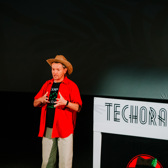Designing and Implementing a Microsoft Azure AI Solution
ai-102
4 days
Interested in a private company training? Request it here.
Not ready to book yet? Request an offer here.
Prepare to develop AI solutions on Azure
Prepare to develop AI solutions on Azure
- Define artificial intelligence
- Understand AI-related terms
- Understand considerations for AI Engineers
- Understand considerations for responsible AI
- Understand capabilities of Azure Machine Learning
- Understand capabilities of Azure Cognitive Services
- Understand capabilities of the Azure Bot Service
- Understand capabilities of Azure Cognitive Search
Create and consume Cognitive Services
Create and consume Cognitive Services
- Provision a cognitive services resource
- Identify endpoints and keys
- Use a REST API
- Use an SDK
- Exercise - Use cognitive services
Secure Cognitive Services
Secure Cognitive Services
- Consider authentication
- Implement network security
- Exercise - Manage Cognitive Services Security
Monitor Cognitive Services
Monitor Cognitive Services
- Monitor cost
- Create alerts
- View metrics
- Manage diagnostic logging
- Exercise - Monitor Cognitive Services
Deploy cognitive services in containers
Deploy cognitive services in containers
- Understand containers
- Use Cognitive Services containers
- Exercise - Use a container
Extract insights from text with the Language service
Extract insights from text with the Language service
- Provision a Language resource
- Detect language
- Extract key phrases
- Analyze sentiment
- Extract entities
- Extract linked entities
- Exercise - Analyze text
Translate text with the Translator service
Translate text with the Translator service
- Provision a Translator resource
- Specify translation options
- Define custom translations
- Exercise - Translate text with the Translator service
Create speech-enabled apps with the Speech service
Create speech-enabled apps with the Speech service
- Provision an Azure resource for speech
- Use the Speech to text API
- Use the text to speech API
- Configure audio format and voices
- Use Speech Synthesis Markup Language
- Exercise - Create a speech-enabled app
Translate speech with the speech service
Translate speech with the speech service
- Provision an Azure resource for speech translation
- Translate speech to text
- Synthesize translations
- Exercise - Translate speech
Build a Language Understanding model
The Language Understanding service enables you to train a language model that apps can use to extract meaning from natural language.
- Understand resources for building a language understanding model
- Define intents, utterances, and entities
- Use patterns to differentiate similar utterances
- Use pre-built entity components
- Train, test, publish, and review a Language Understanding model
- Exercise - Build a Language Understanding model
Publish and use a Language Understanding app
After creating a Language Understanding app, you can publish it and consume it from client applications.
- Understand capabilities of the Language service
- Process predictions
- Use a container
- Exercise - Create a Language Understanding app
Build a question answering solution
Build a question answering solution
- Understand question answering
- Compare question answering to language understanding
- Create a knowledge base
- Implement multi-turn conversation
- Test and publish a knowledge base
- Use a knowledge base
- Improve question answering performance
- Create a question answering bot
- Exercise - Create a question answering solution
Create a bot with the Bot Framework SDK
Learn how to build a bot by using the Microsoft Bot Framework SDK.
- Introduce principles of bot design
- Get started with the Bot Framework SDK
- Implement activity handlers and dialogs
- Deploy a bot
- Exercise - Create a bot with the Bot Framework SDK
Create a Bot with the Bot Framework Composer
Create a Bot with the Bot Framework Composer
- Understand ways to build a bot
- Get started with the Bot Framework Composer
- Understand dialogs
- Understand adaptive flow
- Design the user experience
- Exercise - Create a bot with the Bot Framework Composer
Analyze images
Analyze images
- Provision a Computer Vision resource
- Analyze an image
- Generate a smart-cropped thumbnail
- Exercise - Analyze images with Computer Vision
Analyze video
Analyze video
- Understand Video Analyzer for Media capabilities
- Extract custom insights
- Use Video Analyzer widgets and APIs
- Exercise - Analyze video
Classify images
Classify images
- Provision Azure resources for custom vision
- Understand image classification
- Train an image classifier
- Exercise - Classify images with custom vision
Detect objects in images
Detect objects in images
- Understand object detection
- Train an object detector
- Consider options for labeling images
- Exercise - Detect objects in images with custom vision
Detect, analyze, and recognize faces
Detect, analyze, and recognize faces
- Identify options for face detection analysis and identification
- Understand considerations for face analysis
- Detect faces with the computer vision service
- Understand capabilities of the face service
- Compare and match detected faces
- Implement facial recognition
- Exercise - Detect, analyze, and identify faces
Read Text in Images and Documents with the Computer Vision Service
Azure's Computer Vision service uses advanced algorithms to process images and return information based on the visual features you're interested in. This module teaches you how to use the Azure Computer Vision's Read API.
- Explore Computer Vision options for reading text
- Use the Read API
- Exercise - Read text in images
- Knowledge Check
Extract data from forms with Form Recognizer
Form Recognizer extracts data at scale to enable the submission of documents in real time, at scale, with accuracy. This module gives users the tools to use the Azure Form Recognizer vision API.
- What is Form Recognizer?
- Get started with Form Recognizer
- Understand prebuilt models
- Train custom models
- Use Form Recognizer models
- Exercise - Extract data from custom forms
- Use the Form Recognizer Studio
Create an Azure Cognitive Search solution
Create an Azure Cognitive Search solution
- Azure resources
- Search components
- Understand the indexing process
- Search an index
- Apply filtering and sorting
- Enhance the index
- Exercise - Create a search solution
Create a custom skill for Azure Cognitive Search
Create a custom skill for Azure Cognitive Search
- Create a custom skill
- Add a custom skill to a skillset
- Exercise - Implement a custom skill
Create a knowledge store with Azure Cognitive Search
Create a knowledge store with Azure Cognitive Search
- Define projections
- Define a knowledge store
- Exercise - Create a knowledge store
AI-102 Designing and Implementing an Azure AI Solution is intended for software developers wanting to build AI infused applications that leverage Azure Cognitive Services, Azure Cognitive Search, and Microsoft Bot Framework. The course will use C# or Python as the programming language.
not specified







